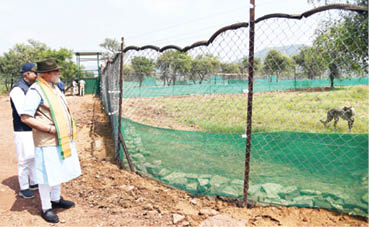Concerns exist over conservation and relocation efforts.
The death of a five-and-a-half year old female Cheetah, Sasha, who was among the eight feline that were brought to India on 17 September from Namibia, has generated questions, both in India and Namibia among the government quarters and wildlife enthusiasts on whether they were lapses on part of the Madhya Pradesh state government in handling the cheetah.
What has added more twist to this sad development that took place on 27 March is that while the Madhya Pradesh government stated that the Cheetah was already suffering from kidney-related ailment much before she was brought to India, this was denied by the Cheetah Conservation Fund (CCF) who stated that her death was likely caused by a “highly stressful situation”.
Almost four weeks after her death, no further clarification has come from either the state government or the central government on how she died. On 27 March, the Madhya Pradesh government, in its official press release, stated that after Sasha was found to be lethargic on 22 March, she was examined and found to have infection in kidney. After this, as per the press release, the government officials reached out to the CCF. As per the medical records shared by the CCF, the release claimed, the last blood test done on Sasha on 15 August in Namibia had found that her creatinine level was 400.
Susan Yannetti, Senior Advisor, Strategic Initiatives at CCF, told The Sunday Guardian that her death has come as a “surprise” as the day before she died, she was reported as being alert and active. According to her, she had no infection, abnormalities when she was checked before being sent to India and her death was likely caused due to the complications that arose due to “highly stressful situations”.
According to the CCF, all the eight cheetahs were selected only after they meet a rigorous criterion; all cheetahs were wild born, clinically healthy and in prime age (2.5 to 6 years old), the genetics of the animals were also considered, as they were selecting the best candidates to be founder stock for the new population.
According to officials in Madhya Pradesh, after her arrival in India, Sasha settled in without any health issues being noted and showed a good appetite. She successfully hunted as soon as she was released into the open and killed a cheetal in December.
However, in January, Sasha started to show symptoms and her health deteriorated quickly. Blood analyses showed kidney failure (creatinine of 761 μmol/L (8.61 mg/dL), which deteriorated to over 1,000 within three days, which as per the CCF is a “very fast progression and not consistent with chronic kidney failure”, which is a common old-cheetah disease that the CCF claimed it was very familiar with and something that it has a lot of experience with.
According to the CCF, she developed haemolytic anaemia and gastritis (vomiting, diarrhoea, lack of appetite, undigested meat in faeces), which is a common pathology in cheetahs that are subjected to highly stressful situations. Till now, no accountability has been fixed on any official to correct the lapses, if any, that led to the death of Sasha.
According to a Bhopal-based senior forest official, more such “complications” are going to arise in the future as far as cheetah conservation is concerned. “Now we are witnessing the Cheetahs moving out of the Kuno part and venturing into nearby forest areas which have human presence and other animals that can pose a danger to its life. What if tomorrow a Cheetah is killed by humans or a pack of domesticated dogs if it reaches a human settlement? The global outcry would be massive and it would damage the whole process of Cheetah rehabilitation. These are the issues that need to be discussed and a plan developed to handle such eventualities,” he said.
According to official sources, the government is mulling to relocate some of the Cheetahs to Rajasthan and another protected forest area in Mandsaur, roughly 400 km from Kuno to ensure that the species are spread across the country which will ensure better survival rate for them.
Among the places that have been identified for this relocation include,Nauradehi Wildlife Sanctuary Madhya Pradesh, Gandhi Sagar Wildlife Sanctuary–Bhainsrorgarh Wildlife Sanctuary complex, Madhya Pradesh, Shahgarh bulge in Jaisalmer, Rajasthan and Mukundara Tiger Reserve as a fenced enclosure site.
“Twenty years down the line, we expect the Cheetahs to move around the country like the Tiger and Leopards do presently. For this it is pertinent that they are ‘settled’ in multiple places so that the species can adapt to the environment,” a wildlife expert associated with the conservation stated. The government plans to introduce 50 cheetahs in various National Parks over the next five years.
According to government officials, there are multiple benefits of a Cheetah population that is prospering. Cheetahs live in open plains; their habitat is predominantly where their prey live—grasslands, scrubs and open forest systems, semi-arid environments and temperatures that tend to be hotter compared to cooler regimes. For having Cheetahs, one would have to save not only its prey-base comprising certain threatened species, but also other endangered species of the grasslands and open forest ecosystems, some of which are on the brink
of extinction.

